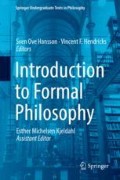Abstract
This chapter deals with an area of study sometimes called “formal value theory” or “formal axiology”. Roughly characterized, this area investigates the structural and logical properties of value properties and value relations, such as goodness, badness, and betterness. There is a long-standing controversy about whether goodness and badness can, in principle, be measured on a cardinal scale, in a way similar to the measurement of well-understood quantitative concepts like length. Sect. 28.1 investigates this issue, mainly by comparing the properties of the relations “longer than” and “better than”. In Sect. 28.2, some attempts to define goodness and badness in terms of the betterness relation are discussed, and a novel suggestion is made. Sect. 28.3, finally, contains an attempt to define the recently much discussed value relation “on a par with” in terms of the more familiar betterness relation.
Access this chapter
Tax calculation will be finalised at checkout
Purchases are for personal use only
Notes
- 1.
Asterisks (*) indicate recommended readings.
References and Recommended Readings
Asterisks (*) indicate recommended readings.
Arrhenius, G. (2005). Superiority in Value. Philosophical Studies, 123, 97–114.
Arrhenius, G., & Rabinowicz, W. (2005). Millian Superiorities. Utilitas, 17, 127–146.
Beardsley, M. (2005 [1965]). Intrinsic value (pp. 61–75). In Rønnow-Rasmussen and Zimmerman (2005).
Bentham, J. (1996 [1789]). An introduction to the principles of morals and legislation. Oxford: Clarendon Press.
Brentano, F. (1969 [1907]). Loving and hating. In R. M. Chisholm (Ed.), The origin of our knowledge of right and wrong. New York: Routledge and Kegan Paul.
Broome, J. (2004). Weighing lives. Oxford: Oxford University Press.
Carlson, E. (2008). Extensive measurement with incomparability. Journal of Mathematical Psychology, 52, 250–259.
Carlson, E. (2010a). Generalized extensive measurement for Lexicographic orders. Journal of Mathematical Psychology, 54, 345–351.
Carlson, E. (2010b). Parity Demystified. Theoria, 76, 119–128.
Carlson, E. (2011a). Non-Archimedean extensive measurement with incomparability. Mathematical Social Sciences, 62, 71–76.
Carlson, E. (2011b). Defining goodness and badness in terms of betterness without negation. In E. Dzhafarov & L. Perry (Eds.), Descriptive and normative approaches to human behavior (pp. 51–66). Hackensack: World Scientific.
Carlson, E. (2015). Organic Unities. In I. Hirose & J. Olson (Eds.), Oxford handbook of value theory (pp. 285–299). Oxford: Oxford University Press.
Carlson, E. (2016). ‘Good’ in terms of ‘Better’. Noûs, 50, 213–223.
Chang, R. (Ed.). (1997). Incommensurability, incomparability, and practical reason. Cambridge, MA/London: Harvard University Press.
* Chang, R. (2002). The possibility of parity. Ethics, 112, 659–688. [Seminal paper, arguing that two items may be “on a par”, and hence evaluatively comparable, although neither is at least as good as the other.]
Chisholm, R. M. (2005 [1986]). Organic unities (pp. 305–318). In Rønnow-Rasmussen and Zimmerman (2005).
* Chisholm, R. M. & Sosa, E. (1966). On the logic of ‘intrinsically better’. American Philosophical Quarterly, 3, 244–249. [Classic discussion of how to define goodness and badness in terms of betterness.]
Danielsson, S. (1997). Harman’s equation and the additivity of intrinsic value. In L. Lindahl, P. Needham, & R. Sliwinski (Eds.), For good measure: Philosophical essays dedicated to Jan Odelstad on the occasion of his fiftieth birthday (pp. 23–34). Uppsala: Uppsala University.
Danielsson, S. (2005 [1998]). Harman’s equation and non-basic intrinsic value (pp. 371–378). In Rønnow-Rasmussen and Zimmerman (2005).
Hansson, S. O. (1990). Defining ‘good’ and ‘bad’ in terms of ‘better’. Notre Dame Journal of Formal Logic, 31, 136–149.
Krantz, D. H., Duncan Luce, R., Suppes, P., & Tversky, A. (1971). Foundations of measurement, vol. 1: Additive and polynomial representations. New York/London: Academic Press.
Moore, G. E. (1903). Principia Ethica. Cambridge: Cambridge University Press.
Packard, D. J. (1975). A note on Wittgenstein and cyclical comparatives. Analysis, 36, 37–40.
Quinn, P. L. (2005 [1977]). Improved foundations for a logic of intrinsic value (pp. 241–248). In Rønnow-Rasmussen and Zimmerman (2005).
Quinn, W. S. (1990). The puzzle of the self-torturer. Philosophical Studies, 59, 79–90.
Rachels, S. (1998). Counterexamples to the transitivity of Better Than. Australasian Journal of Philosophy, 76, 71–83.
Regan, D. (1997). Value, comparability, and choice (pp. 129–150). In Chang (1997).
* Roberts, F. S. (2009 [1979]). Measurement theory: With applications to decisionmaking, utility, and the social sciences. Cambridge: Cambridge University Press. [Comprehensive but relatively accessible introduction to measurement theory, with applications relevant to value theory.]
* Rønnow-Rasmussen, T. & Zimmerman, M. J. (eds.). (2005). Recent work on intrinsic value. Dordrecht: Springer. [Useful collection of papers on formal and substantial axiology.]
Ross, W. D. (1930). The right and the good. Oxford: Clarendon Press.
Temkin, L. S. (1996). A continuum argument for intransitivity. Philosophy & Public Affairs, 25, 175–210.
* Zimmerman, M. J. (2001). The Nature of Intrinsic Value. Lanham: Rowman & Littlefield. [In-depth treatment of the structural properties of intrinsic value.]
Author information
Authors and Affiliations
Corresponding author
Editor information
Editors and Affiliations
Rights and permissions
Copyright information
© 2018 Springer International Publishing AG, part of Springer Nature
About this chapter
Cite this chapter
Carlson, E. (2018). Value Theory (Axiology). In: Hansson, S., Hendricks, V. (eds) Introduction to Formal Philosophy. Springer Undergraduate Texts in Philosophy. Springer, Cham. https://doi.org/10.1007/978-3-319-77434-3_28
Download citation
DOI: https://doi.org/10.1007/978-3-319-77434-3_28
Published:
Publisher Name: Springer, Cham
Print ISBN: 978-3-319-77433-6
Online ISBN: 978-3-319-77434-3
eBook Packages: Religion and PhilosophyPhilosophy and Religion (R0)

